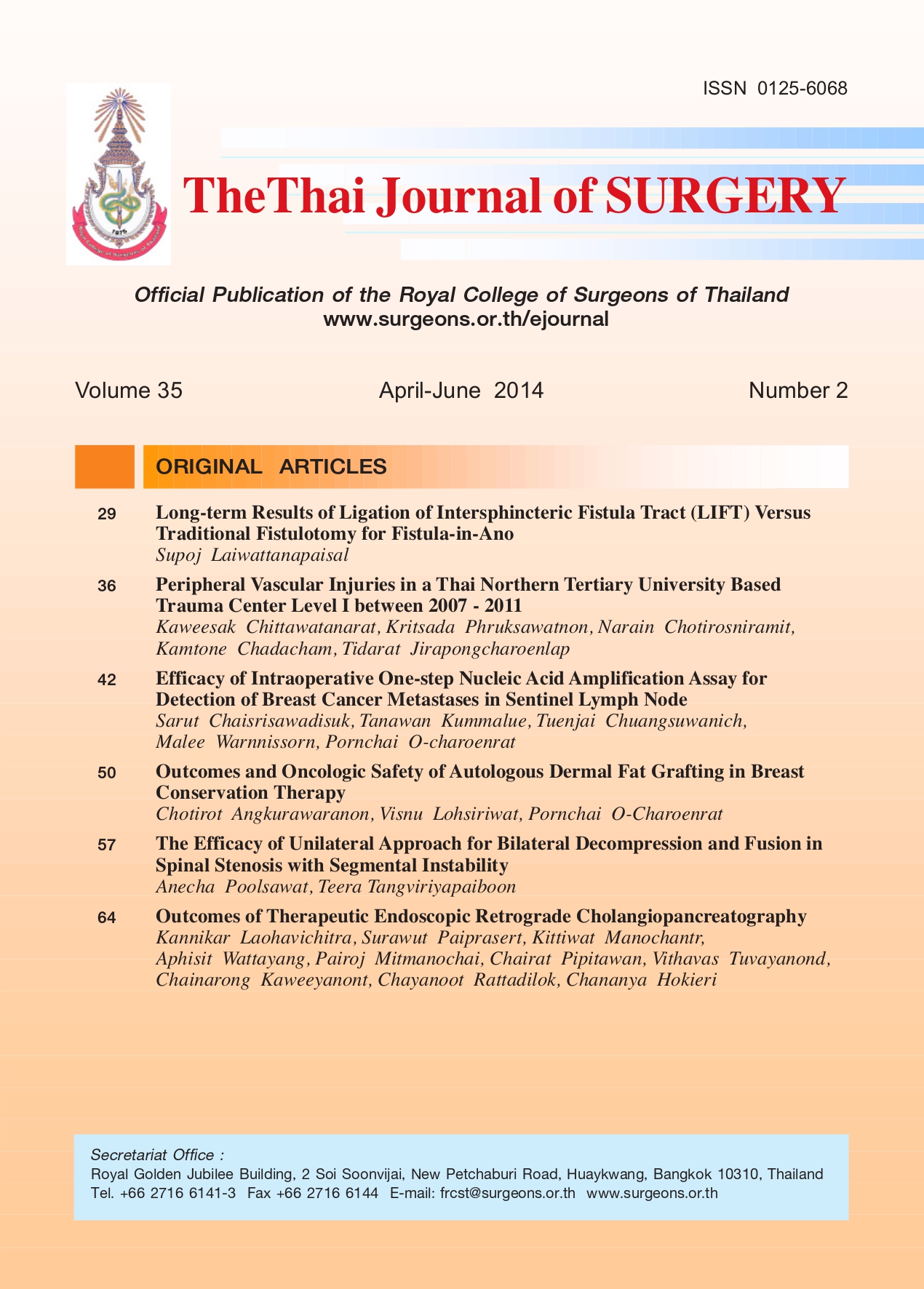Long-term Results of Ligation of Intersphincteric Fistula Tract (LIFT) Versus Traditional Fistulotomy for Fistula-in-Ano
Keywords:
Fistula-in-ano, ligation of intersphincteric fistula tract, FistulotomyAbstract
Objective: To determine and compare the post-operative outcomes for a LIFT operation and traditionalfistulotomy for treatment of anal fistulas.
Background: No single technique is appropriate for the treatment of all fistula-in-ano cases; therefore, treatment
must be determined by the etiology and anatomy of the fistula, degree of symptoms, patient co-morbidities, recurrence
rate, incontinence rate and the surgeon’s experience. LIFT is a new technique that has the advantages of anal sphincter
preservation and less extensive surgery. This current study compares LIFT with traditional fistulotomy.
Material and Methods: We retrospectively studied 64 fistula-in-ano patients who underwent surgery. All cases took
place between July 20, 2008 and June 30, 2009. Patient characteristics, including sex, age, fistula-in-ano classification,
operative time, healing time, recurrence rate, incontinence rate and any complications, were obtained by reviewing each
patient’s medical record.
Results: Thirty-two patients underwent the LIFT procedure, and 32 patients underwent fistulotomy. The mean
patient age was 38.84 ± 9.64 years in the LIFT group and 36.18 ± 12.14 years in the fistulotomy group (P = 0.337). The
majority of cases were simple fistula-in-ano. Simple fistula-in-ano cases comprised 78.1% of the LIFT group and 81.3%
of the fistulotomy group (P = 1.000). The fistula tract shape was typically straight (90.6%) and was equally prevalent in
both groups (P = 1.000). The fistula tract length from anal verge was 3.10 ± 1.78 cm in the LIFT group. The most frequent
internal opening site of the LIFT group was at 6 o′ clock (31.3%). The most frequent external opening site of the LIFT
group was at 5 o′ clock. The number of external openings was not different between the groups (P = 0.173). The healing
time was 33.54 ± 8.18 days for the LIFT group and 29.90 ± 9.76 days for the fistulotomy group (P = 0.290). The healing
rate was 81.2% and the local failure rate was 18.3% in the LIFT group. The recurrence rate was 9.4% in the fistulotomy
group, and there was no recurrence in the LIFT group. There were no incontinence cases for either group.
Conclusion: The LIFT technique preserves the anal sphincter muscle for fistula-in-ano patients. The procedure
is safe, shows minimal complications, no recurrence and no incontinence when compared with traditional fistulotomy.
References
parameters for the management of perianal abscess and
fistula-in-ano. Dis Colon Rectum 2011;54(12):1465-74.
2. Rojanasakul A, Pattanaarun J, Sahakitrungruang C,
Tantiphlachiva K. Total anal sphincter saving technique for
fistula-in-ano; the ligation of intersphincteric fistula tract. J
Med Assoc Thail 2007;90(3):581-6.
3. Liu WY, Aboulian A, Kaji AH, Kumar RR. Long-term results of
ligation of intersphincteric fistula tract (LIFT) for fistula-in-ano.
Dis Colon Rectum 2013;56(3):343-7.
4. Shanwani A, Nor AM, Nil Amri MK. Ligation of the
intersphincteric fistula tract (lift): A sphincter-saving technique
for fistula-in-ano. Dis Colon Rectum 2010;53(1):39-42.
5. Tan KK, Tan IJ, Lim FS, Koh DC, Tsang CB. The anatomy of
failures following the ligation of intersphincteric tract
technique for anal fistula: A review of 93 patients over 4
years. Dis Colon Rectum 2011;54(11):1368-72.
6. Rojanasakul A. LIFT procedure: A simplified technique for
fistula-in-ano. Tech Coloproctol 2009;13(3):237-40.
7. Bleier JIS, Moloo H, Goldberg SM. Ligation of the
intersphincteric fistula tract: An effective new technique for
complex fistulas. Dis Colon Rectum 2010;53(1):43-6.
8. Garcia-Aguilar J, Belmonte C, Douglas Wong W, Goldberg
SM, Madoff RD. Anal fistula surgery: Factors associated with
recurrence and incontinence. Dis Colon Rectum 1996;
39(7):723-9.
9. Davies M, Harris D, Lohana P, Chandra Sekaran TV, Morgan
AR, Beynon J, et al. The surgical management of fistula-inano
in a specialist colorectal unit. Int J Colorectal Dis
2008;23(9):833-8.
10. Hyman N, O’Brien S, Osler T. Outcomes after fistulotomy:
Results of a prospective, multicenter regional study. Dis
Colon Rectum 2009;52(12):2022-7.
11. Sahakitrungruang C, Pattana-arun J, Khomvilai S,
Tantiphlachiva K, Atittharnsakul P, Rojanasakul A.
Marsupialization for simple fistula in ano: A randomized
controlled trial. J Med Assoc Thai 2011;94(6):699-703.
12. Sirikurnpiboon S, Awapittaya B, Jivapaisarnpong P. Ligation
of intersphincteric fistula tract and its modification: Results
from treatment of complex fistula. World J Gastrointest Surg
2013;5(4):123.
13. Theerapol A, So BY, Ngoi SS. Routine use of setons for the
treatment of anal fistulae. Singapore Med J 2002;43(6):
305-7.
14. Eitan A, Koliada M, Bickel A. The use of the loose seton
technique as a definitive treatment for recurrent and
persistent high trans-sphincteric anal fistulas: A long-term
outcome. J Gastrointest Surg 2009;13(6):1116-9.
15. Dudukgian H, Abcarian H. Why do we have so much
trouble treating anal fistula? World J Gastroenterol
2011;17(28):3292-6.
Downloads
Published
How to Cite
Issue
Section
License
Articles must be contributed solely to The Thai Journal of Surgery and when published become the property of the Royal College of Surgeons of Thailand. The Royal College of Surgeons of Thailand reserves copyright on all published materials and such materials may not be reproduced in any form without the written permission.



